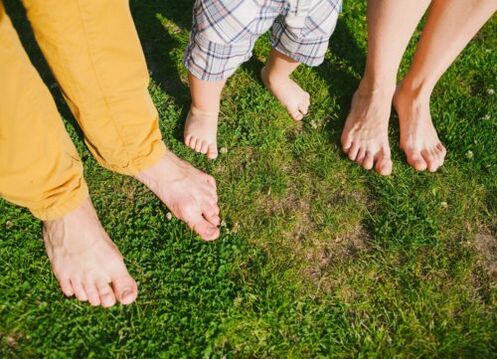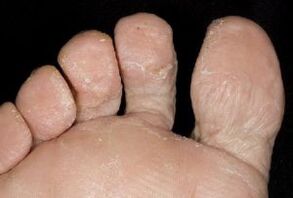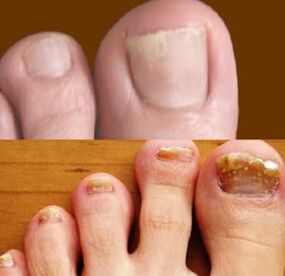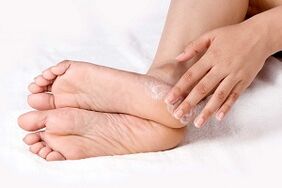This group of infectious diseases includes fungus on the legs, which is a type of fungal disease. This pathology is caused by microscopic fungi. The disease of the nail plate is called onychomycosis.

Foot fungal lesions
This is a very common disease in both men and women. The most common types of fungal diseases are:
- Trichophytonosis;
- Candidiasis;
- Epidermophytosis.
Some fungi can infect animals and humans. It is not only necessary to know what fungal disease is, but it is also necessary to know why it develops. The main mechanism of human infection is contact. It is achieved in direct and indirect ways. In the first case, the fungus climbs up on the feet when it comes in contact with soil, plants, or sick people. There have been reports of family infections.
The indirect transmission of pathogens is achieved through contact with animal care products and patients' personal items. These can be shoes, towels and scissors, and bathroom accessories.
Transmission factors are usually socks, stockings and other personal items. Foot fungus can develop after visiting public baths and swimming pools. The procedure involves the skin of the legs and the nail plate.
The contributing factors are:
- Increased sweating in the legs;
- The presence of corns and scratches;
- Wear tight shoes;
- Not paying attention to personal hygiene;
- Wear someone else's shoes;
- Dormitory accommodation
- Weakened immunity;
- Malnutrition;
- There are other skin diseases;
- Vitamin deficiency;
- Alcohol addiction;
- smokes;
- Walk barefoot
- Endocrine disorders.

Weak people are more likely to face this problem.
General clinical manifestations
The fungus on the soles of the feet and nails will not be noticed for a long time. For this disease, the following symptoms are observed:
- Skin peeling;
- dry;
- The presence of diaper rash;
- Thickening of the skin and nail plate;
- Fragile nails;
- Redness;
- Itching;
- White or pale yellow flowers;
- The existence of erosion;
- Sore skin.
The fungus on the feet looks different. It all depends on the type of pathogen and the underlying disease. Sometimes, unpleasant smells leave people. The fungus on the feet does not cause the general condition to deteriorate. There are no symptoms of poisoning because fungi are conditional pathogenic microorganisms and are located on the surface of the skin.

One leg is affected first. The fungus is then introduced into the second limb. In most cases, the process involves the following areas:
- The back of the foot
- The gap between 4 to 5 fingers;
- Nail board.
According to clinical signs, the scaly, sweaty, and interlaced forms of the disease can be distinguished. In the first case, scales appear on the reddened skin. Peeling was observed. Itching is an intermittent sign. He will not disturb all patients. For fungal hyperhidrosis, air bubbles appear on the fornix. Their size can grow. A few days later, they were opened. Erosion appears in their place. Areas where diaper rash appears. As the erosion dried up, spalling was observed.
If the fungus on the skin of the feet is complicated by a bacterial infection, the exudate will become purulent. Pain appears. Fever is possible. Fungal infections sometimes cause the development of intertrigomycosis. Its main feature is the presence of cracks with white edges. Exudation develops over time. Soreness occurs. Erosion is formed in the crack area. This form of disease occurs in a chronic form and worsens in the summer.
Development of leg onychomycosis
In addition to fungus on the feet, onychomycosis can also be found. With it, nails participate in this process. The prevalence of this pathology in the population is 10-20%. In recent years, the prevalence of children has been on the rise. The fungus actively grows and multiplies not only on the skin but also on the nail plate.
People with varicose veins, hyperhidrosis, flat feet and endocrine diseases often face similar problems. The fungus multiplies in the nail and gradually causes its destruction. If the disease is not cured, then it can last for several years. The end result is nail loss. Hyperkeratosis often occurs.

Distinguish between hypertrophic, normal nutritional and atrophic onychomycosis. In the first case, the nails become dull and thick. As it shrinks, the color of the board changes to brown. It was observed to detach. For positive trophic onychomycosis, the shape and size of the nail will not change. With the development of onychomycosis of the foot, the following symptoms are observed:
- Decreased nail density;
- Change its color;
- There are white or yellow spots;
- Itching;
- Cracked skin;
- Peeling
- Thickening of plates;
- Increased vulnerability.
If the nail fungus is not treated, there is a risk of developing paronychia. In this case, purulent inflammation of the nail bed occurs.
Examination and treatment strategies
Not only do you need to know how the fungus starts to grow on your feet, you also need to know how to get rid of it. The treatment plan is determined by the attending physician. Before that, the following research needs to be carried out:
- Check with a wooden lamp;
- Microscopic examination of scraping;
- General clinical analysis;
- Sow seeds on nutrient media.

Differential diagnosis of psoriasis, nail dystrophy, lichen planus, congenital thick onychomycosis, trauma and eczema.
Every experienced dermatologist knows how to treat toenail fungus. Antifungal drugs are used in the form of solutions, creams and varnishes.
Toe fungus treatment usually involves surgery. The affected nail was removed.
With the long-term course of epidermophytosis, systemic foot fungus treatment based on miconazole or ketoconazole can be prescribed. Proper treatment will kill the bacteria. There are products on sale that are suitable for the passage of the affected nail plate. They come in the form of patches.
In order to increase the effectiveness of the treatment of skin fungus on the legs, vitamins, antibiotics (in the case of secondary infections) and various ointments based on zinc and salicylic acid are prescribed.
You also need to follow some rules:
- You should wash your feet every day.
- Change socks more frequently.
- After treatment, the old objects should be thrown away.
- Socks, tights and stockings should be washed in separate basins.
- When fungus is found on the feet, if you wear closed slippers, the treatment will be successful.
At the end of the treatment, a controlled study of Gua Sha was carried out.
























